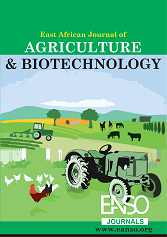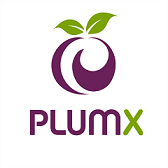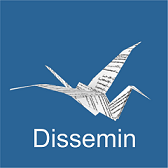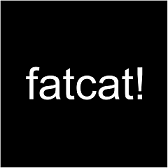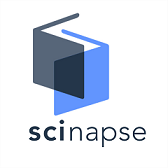Value Chain Mapping of Edible Termites (Macrotermes subhylanus) as an Alternative Source of Income to Rural Livelihoods in Alego Usonga
Résumé
Reducing food insecurity remains a public policy challenge in developing countries. Food insecurity becomes severe in areas where households highly depend on undiversified livelihoods. Entomophagy has been perceived as a solution towards food security due to its nutritional benefits, environmentally friendly attributes and its potential to generate income. However, information to aid its commercialisation is limited, hence the need for value chain mapping. This paper assesses the value chain of edible termites (Macrotermes subhylanus) in Alego Usonga Sub County with the aim of promoting it as an alternative source of income. This study sought to understand the value chain actors from input supplier to consumption and their role in the value chain. Simple random sampling was used to obtain participants for the study. Face-to-face interviews and structured questionnaires were administered to 225 respondents to collect data on value chain actors and their roles. Value chain mapping technique was used for functional and technical analysis of the alate termites’ value chain. The data was analysed using descriptive statistics Chi-square tests, with the aid of Statistical Package for the Social Science (SPSS) version 20. Value chain actors in the termite value chain included input suppliers (1.8), producers/collectors (4%), retailers (13.3%) and consumers (80.9). There was a significant difference (P ≤ 0.05) in terms of input supplier and producer/ collectors of termites; a high significant difference (P ≤ 0.001) was also recorded in hawkers and retailers, where women were reported to play a vital role in hawking and retailing of termites. In terms of transportation, human transport (82.7%) was preferred over motorbikes. Although the value chain actors agreed that edible termites could contribute to additional sources of income, the sector was insufficiently supported by farmer groups and associations, lending institutions, research, and extension service providers
##plugins.generic.usageStats.downloads##
Références
Alemu, M. H., Olsen, S. B., Vedel, S. E., Pambo, K. O., & Owino, V. O. (2015). Consumer acceptance and willingness to pay for edible insects as food in Kenya: the case of white-winged termites (No. 2015/10). IFRO working paper.
Anyuor, S., Ayieko, M., & Amulen, D. (2022). Commercialisation of Alate termites (macrotermes sp.) to improve households’ livelihoods in Vihiga County, Kenya. African Journal of Food, Agriculture, Nutrition and Development, 22(1), 19326-19338.
CAROLINE, K. N. (2018). Evaluation Of Consumers Acceptance and Pricing of Edible Winged Termites (Macrotermes Subhylanus) in Kimilili Sub-County, Kenya. Interciencia.
County Government of Siaya. (2018). Annual Development Plan 2017-2018.
Ishtiaq, M. (2019). Book review Creswell, J. W. (2014). Research design: qualitative, quantitative, and mixed methods approach. Thousand Oaks, ca: sage. English Language Teaching, 12(5), 40.
Kinyuru, J. N., & Ndung’u, N. W. (2020). Promoting edible insects in Kenya: Historical, present, and future perspectives towards establishment of a sustainable value chain. In Journal of Insects as Food and Feed. https://doi.org/10.3920/JIFF2019.0016
Kinyuru, J. N., Kenji, G. M., & Njoroge, M. S. (2009). Process development, nutrition and sensory qualities of wheat buns enriched with edible termites (Macrotermes subhylanus) from Lake Victoria region, Kenya. African Journal of Food, Agriculture, Nutrition and Development, 9(8).
Kinyuru, J. N., Konyole, S. O., Roos, N., Onyango, C. A., Owino, V. O., Owuor, B. O., Estambale, B. B., Friis, H., Aagaard-Hansen, J., & Kenji, G. M. (2013). Nutrient composition of four species of winged termites consumed in western Kenya. Journal of Food Composition and Analysis. https://doi.org/10.1016/j.jfca.2013.02.008
Kinyuru, J. N., Mogendi, J. B., Riwa, C. A., & Ndung’u, N. W. (2015). Edible insects-A novel source of essential nutrients for human diet: Learning from traditional knowledge. Animal Frontiers. https://doi.org/10.2527/af.2015-0014
Kusia, E. S., Borgemeister, C., Tanga, C. M., Ekesi, S., & Subramanian, S. (2021). Exploring community knowledge, perception, and practices of entomophagy in Kenya. International Journal of Tropical Insect Science, 41, 2237-2246.
Lakemond, C. M. M., Veldkamp, T., & van Huis, A. (2019). Edible insects: The value chain. Journal of Insects as Food and Feed. https://doi.org/10.3920/JIFF2019.x006
Mahajan, S. S., Kumar, A., & Agarwal, S. (2022). Nutritional aspects of entomophagy as future food for livelihoods.
Nassiuma, D. K. (2000). Survey sampling: Theory and methods. Nairobi.
Nechifor, V., Ramos, M. P., Ferrari, E., Laichena, J., Kihiu, E., Omanyo, D., ... & Kiriga, B. (2021). Food security and welfare changes under COVID-19 in Sub-Saharan Africa: Impacts and responses in Kenya. Global food security, 28, 100514.
Niassy, S., Musundire, R., Ekesi, S., & van Huis, A. (2018). Edible insect value chains in Africa. Journal of Insects as Food and Feed, 4(4), 199–201. https://doi.org/10.3920/JIFF2018.X005
Odongo, W., Okia, C. A., Nalika, N., Nzabamwita, P. H., Ndimubandi, J., & Nyeko, P. (2018). Marketing of edible insects in Lake Victoria basin: the case of Uganda and Burundi. Journal of Insects as Food and Feed, 4(4), 285-293.
Ogal, P. O., Ayieko, M., & Angira, C. (2022). Consumer Religiosity and Its Influence on Their Uptake and Consumption of Edible Insects among Selected Communities in Western Kenya.
Copyright (c) 2023 Immaculate Nasimiyu Shikoli, Christopher Obel Gor, PhD, Elijah Museve, PhD

Ce travail est disponible sous la licence Creative Commons Attribution 4.0 International .

